The traces we leave behind: uncovering the archaeology of the archaeologists
Ian Blair
Whilst writing the post about the Milk Street mikveh discovered beneath the basement of the State Bank of India at 20-30 Gresham Street, my mind turned to another memorable aspect of the excavation in this area.
The footprint of the basement overlay the earlier DUA Milk Street (MLK76) excavation, a fact that was to be graphically illustrated during the initial clearance of the area by the discovery of a host of contemporary detritus thrown back into infilled archaeological features excavated during the earlier campaign. It is surprising how difficult it can be to identify previously excavated pits that have then been filled with archaeological spoil from an on-going excavation, which invariably contain finds that have been missed, and which even over a relatively short time has then compacted down again, so the presence of contemporary detritus is a welcome and useful indicator.
This time-capsule of the mid-1970’s included a large crumpled ‘A0’ sheet of Permatrace (clearly once pinned on an external notice board on the site hoarding), with a written appeal for donations to the ‘City of London Archaeological Trust Fund’ which usefully incorporated a hand-drawn 3D plan of the on-going Milk Street excavation complete with north arrow: the first time I have excavated a site plan showing the archaeology that we had yet to excavate! Also found were the habitual assortment of contemporary ephemera including drinks cans, numerous Ski yoghurt pots (which I had forgotten in the 1970’s had an inverted form with a wider base and narrower tapering top), and countless finds bags and labels, including one in red biro in the unmistakable hand of former DUA supervisor Patrick Allen.
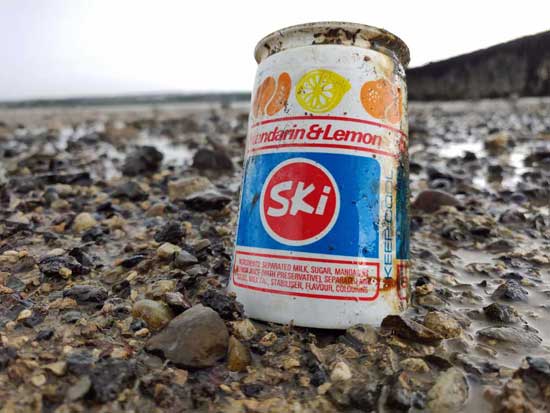 Old style Ski yogurt pot washed up on the Thames foreshore, not thought to have been discarded by an archaeologist!
Old style Ski yogurt pot washed up on the Thames foreshore, not thought to have been discarded by an archaeologist!
Almost a decade earlier in 1992 we had uncovered a similar but larger treasure trove of archaeological memorabilia when we emptied the former Guildhall Art Gallery (GAG87) trenches in advance of the main Guildhall amphitheatre (GYE92) excavation. Commonly known on site as ‘Gina’s Black Museum’ it ultimately filled two large Sunblest bread-crates, with the largest finds being a shovel and a hoe, and smaller items including a hand shovel, tapes, plumb-bobs, assorted stationery, drinks cans (of the soft and alcoholic variety), finds bags and labels, and on a personal note my Dunlop Green Flash plimsoles discarded as part of a long-standing closure deposit tradition, in the base of the trench I had excavated with Denis Ballard four years earlier.
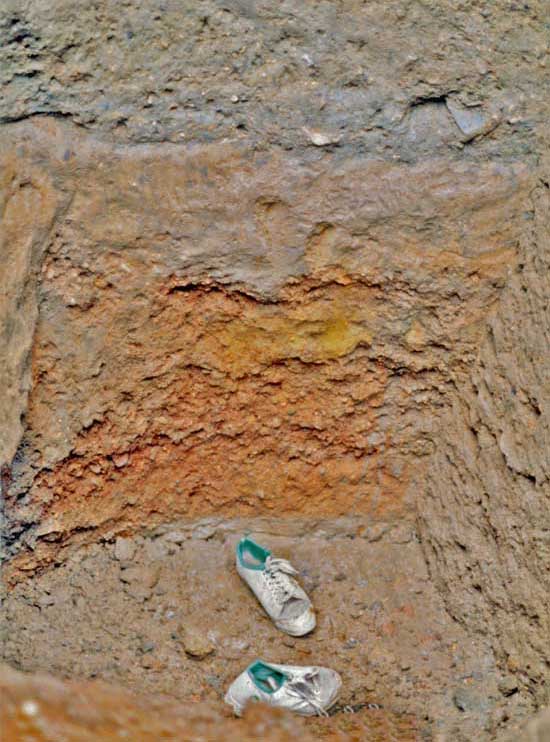 My Dunlop Green Flash plimsoles thrown into an excavated pit on Gutter Lane (ABC87) at the end of the excavation. Unlike the pair I previously discarded on the Guildhall Art Gallery (GAG87) these have yet to be rediscovered
My Dunlop Green Flash plimsoles thrown into an excavated pit on Gutter Lane (ABC87) at the end of the excavation. Unlike the pair I previously discarded on the Guildhall Art Gallery (GAG87) these have yet to be rediscovered
As more of our earlier DUA excavations in the City of London are revisited as buildings are once again torn-down and redeveloped, further traces of the archaeologists who worked on these sites periodically come to light. Individual stray finds include a sandal attributed to Charlotte Harding who worked on Trig Lane (TL74) in 1974, rediscovered twenty-five years afterwards on the Millennium Bridge excavation (MBC98), and from another Gustav Milne site at Pudding Lane (PDN81) uncovered thirty years later at Centurion House (MNU11), a woman’s size wellie and a Guinness can, sporting an advert for a competition ending in 1982.
In an earlier short post on ‘Dig Ventures’ written by Raksha Dave who had worked on Centurion House, the Guinness can was attributed to Prince Chitwood. Whilst I have little doubt that it was thrown into the trench by an archaeologist at the end of the Pudding Lane excavation, I suspect that it does not have its origins in Prince who invariably drank beer or lager, although he did go off-piste somewhat on the Guildhall Art Gallery excavation, by buying bootleg ‘Poitín’ (Irish Moonshine) in plastic bottles, illicitly distilled by Denis an Irish attendant labourer who worked with us on site.
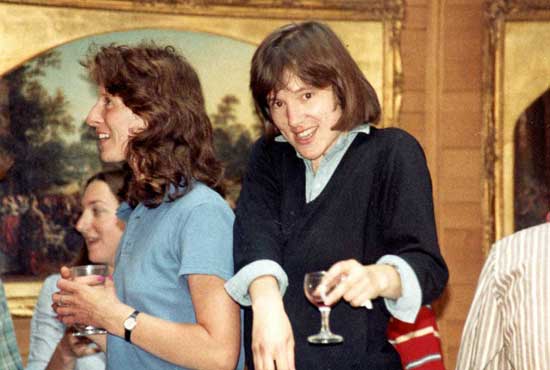 Charlotte ‘One-Sandal’ Harding and photographer Jan Scrivener doing a passable impression of Richard 111 at a boardroom do at the Museum of London in the 1980s
Charlotte ‘One-Sandal’ Harding and photographer Jan Scrivener doing a passable impression of Richard 111 at a boardroom do at the Museum of London in the 1980s
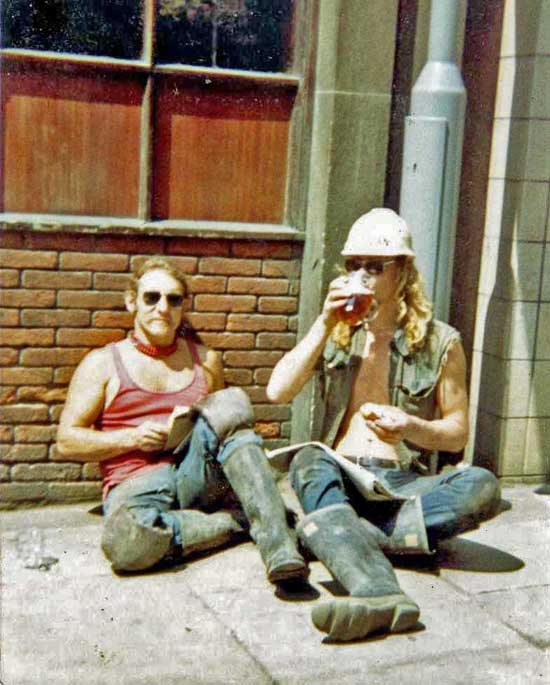 Prince Chitwood and Nick Bateman having a lunchtime beer outside the Britannia pub in Fish Street Hill in 1981
Prince Chitwood and Nick Bateman having a lunchtime beer outside the Britannia pub in Fish Street Hill in 1981
**Note: In the days before more rigid health and safety on archaeological sites, empty drink cans were frequently used to cover the tops of metal grid stakes, to avoid the risk of inadvertently sitting on one, which was known to happen on occasions!

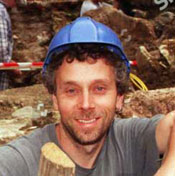

Comments powered by CComment